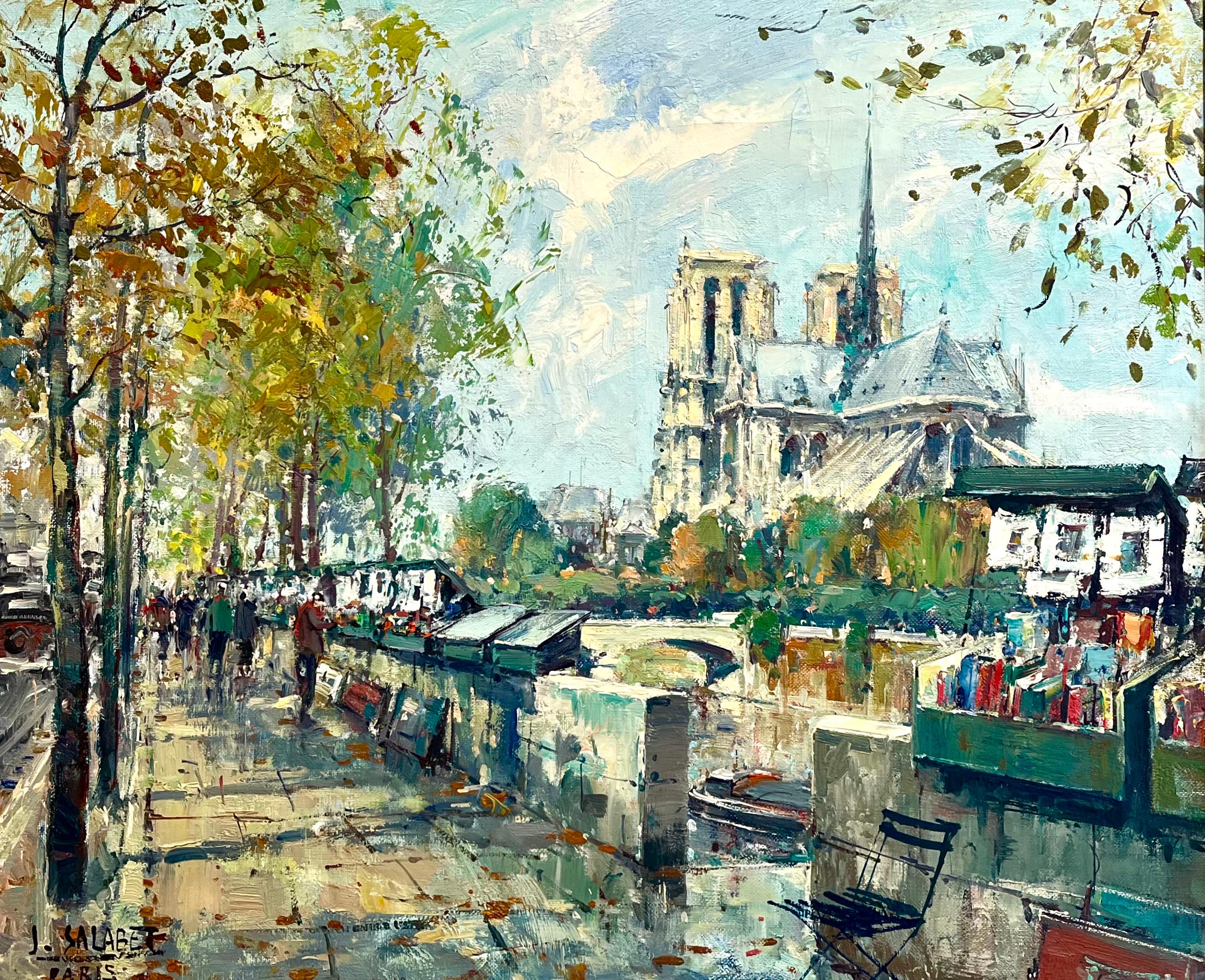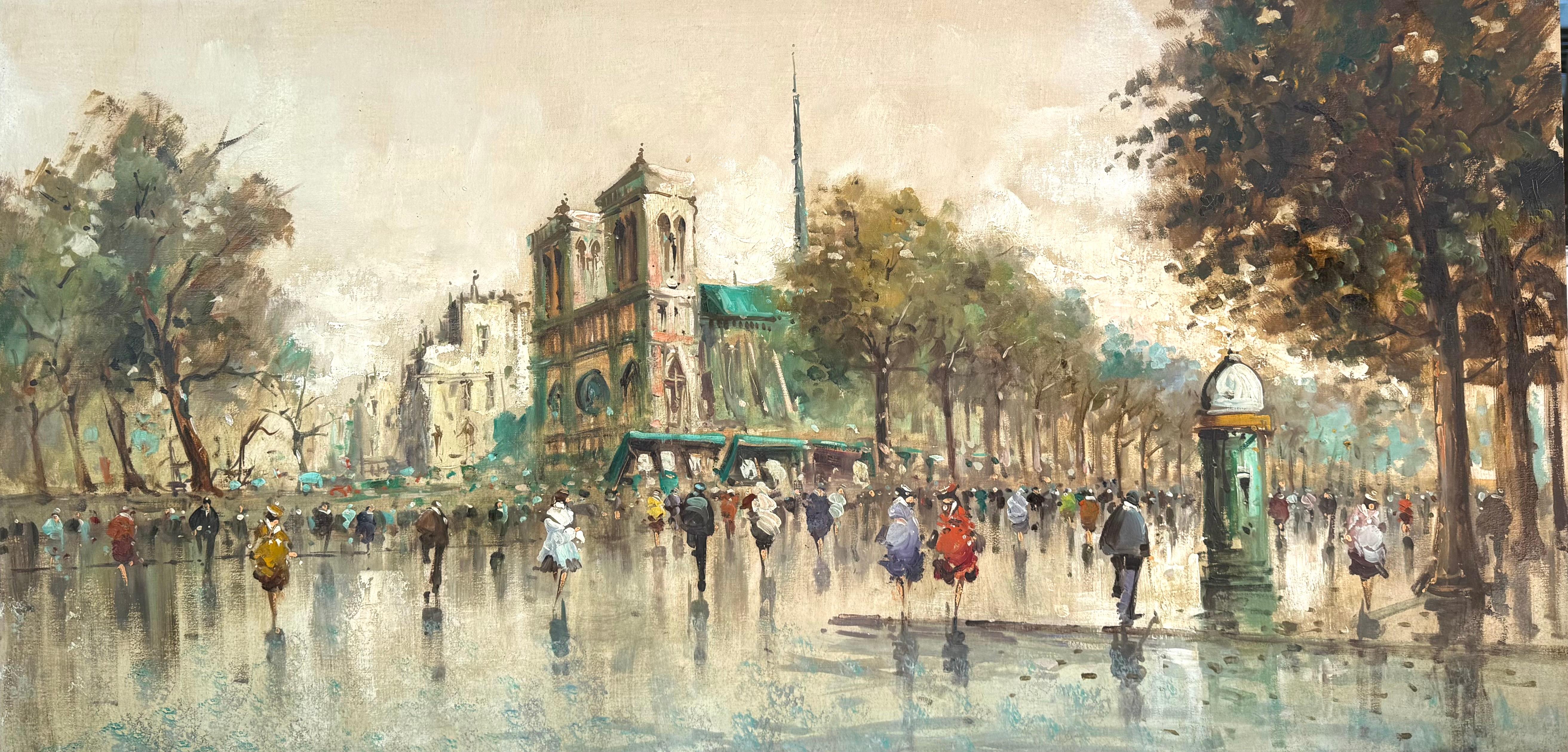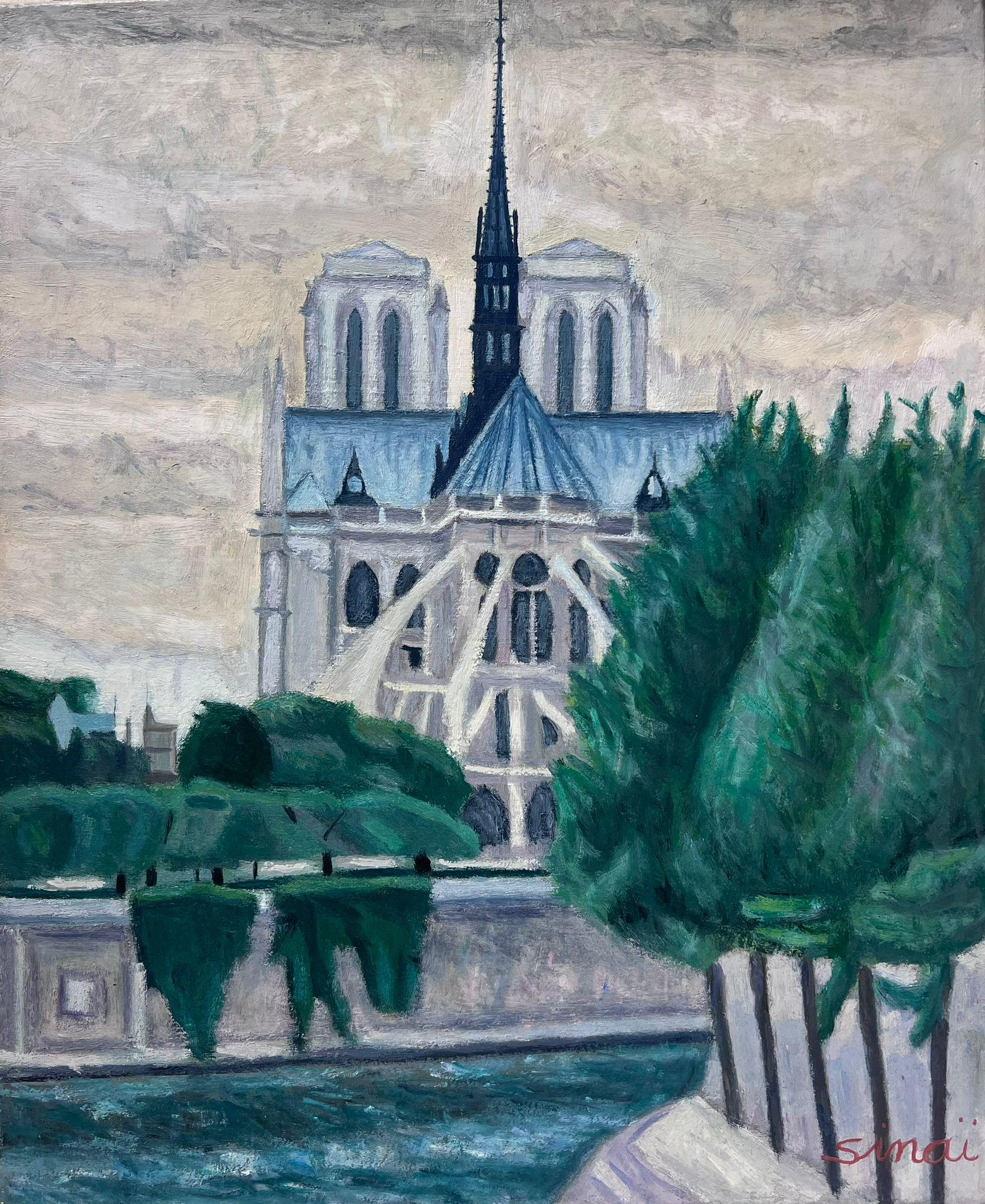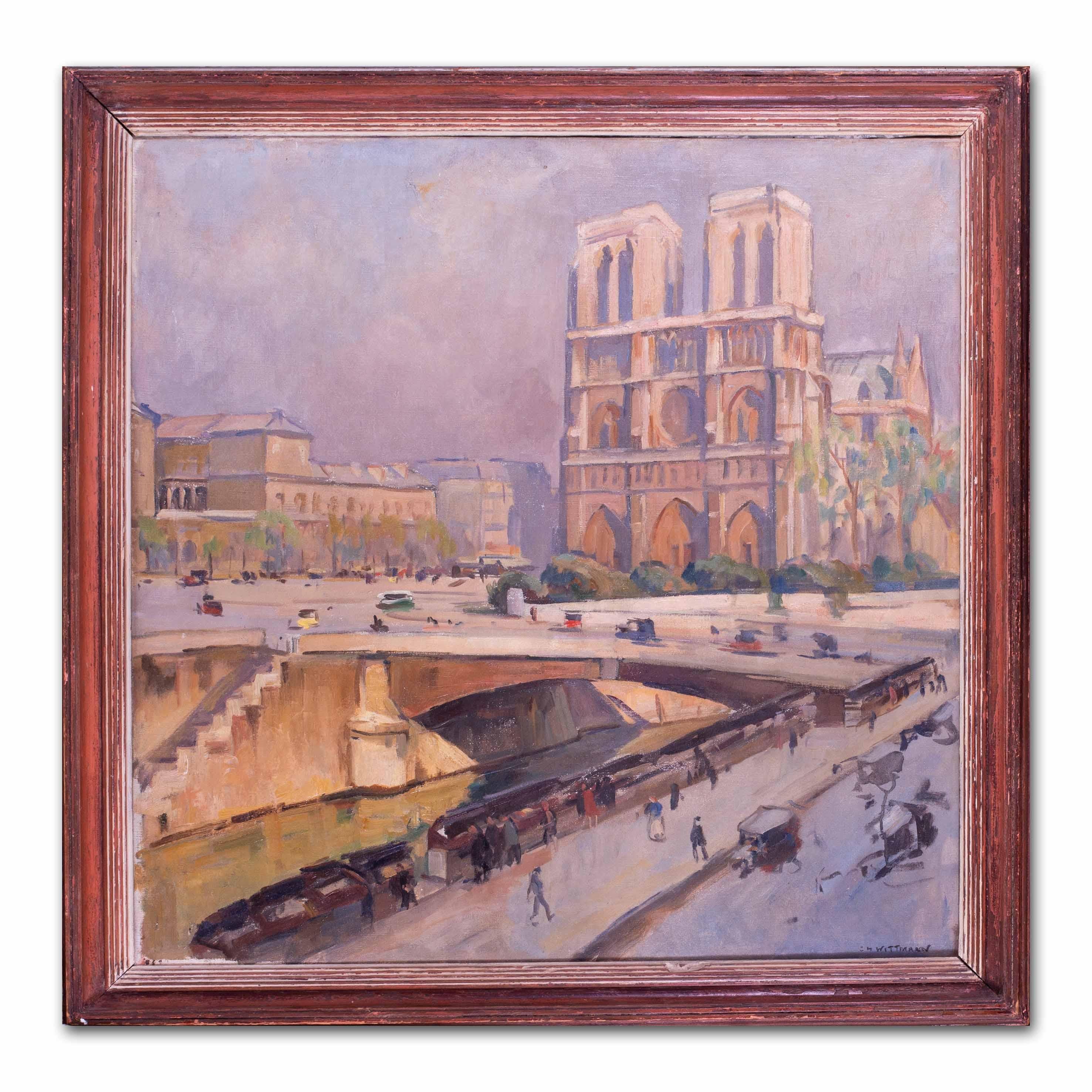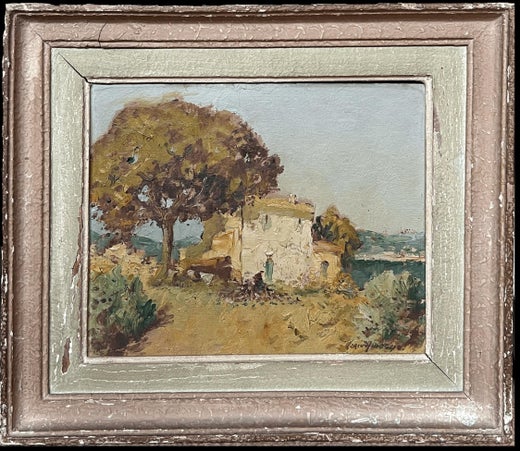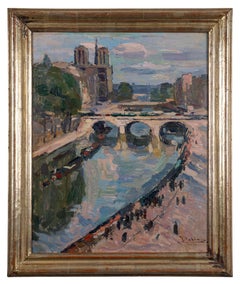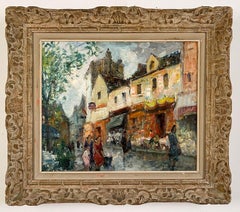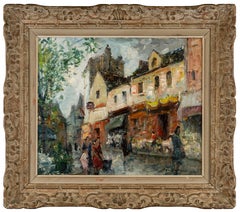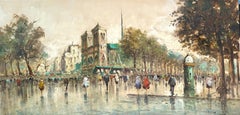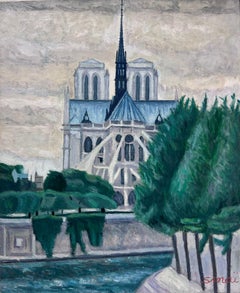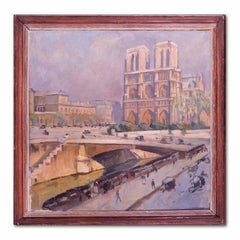Items Similar to Notre Dame, Autonne
Want more images or videos?
Request additional images or videos from the seller
1 of 8
Merio Ameglio, 1897-1970Notre Dame, Autonne1940's
1940's
$4,500
£3,374.09
€3,911.75
CA$6,279.99
A$7,014.17
CHF 3,644.78
MX$85,418.50
NOK 46,296.81
SEK 43,624.94
DKK 29,186.43
Shipping
Retrieving quote...The 1stDibs Promise:
Authenticity Guarantee,
Money-Back Guarantee,
24-Hour Cancellation
About the Item
Merio Ameglio
Italian, 1897-1970
Notre Dame, Autonne
Oil on Canvas
18 by 21 ½ in. W/frame 26 by 29 ½ in.
Signed lower left & titled on reverse
Merio noted impressionist painter primarily known for his landscapes & cityscapes, seascapes & harbor views from his extensive travels throughout the Mediterranean and various regions in Europe, as well as winter scenes, mountainscapes, historic landmarks & famous buildings and cathedrals scenes, human genre/activity & nudes, market scenes and still lifes.
Ameglio was born October 4, 1897 in San Remo, Italy and was raised in the aristocratic intimacy of the Cote d’ Azure amidst the promenade and the Mediterranean Sea. After his formative years of painting along the French coast, Ameglio moved to Paris in 1938 where he continued to explore and perfect his artistic abilities. Montmartre became not only his main residence but also the beginning of his cultural awakening. Although considered to be self taught, his formal education was provided in the bohemian arts area through his encounters and friendships with other popular avant-garde artists, such as; Pablo Picasso, Jacques Villon, Gino Severini, Van Dongen and Jean Paul Francois Galle. Ameglio established his atelier within walking distance of the heart of Montmartre, la Butte, at 23, rue Clauzel.
Ameglio became a member of the Paris Salons and exhibited regularly there. In 1938, during the International Art Exposition he won considerable acclaim and was awarded his first honorable mention for the painting "Cathedrale de Rouen". In October 1969, a year before his passing, a retrospective exhibition of his work was held a year before his death at the Galerie Cambaceres in Paris. He primarily worked in oil, but worked in various other mediums as well. His work can be found in numerous private and public collections worldwide. He died at his home in Montmartre, Paris on July 29, 1970.
Provenance:
Private Collection New York
Le Trianon Fine Art & Antiques
Art A48
- Creator:Merio Ameglio, 1897-1970 (1897 - 1970, French)
- Creation Year:1940's
- Dimensions:Height: 26 in (66.04 cm)Width: 29.5 in (74.93 cm)Depth: 2 in (5.08 cm)
- Medium:
- Movement & Style:
- Period:
- Condition:
- Gallery Location:Sheffield, MA
- Reference Number:Seller: Art A481stDibs: LU70036028712
Merio Ameglio, 1897-1970
Noted impressionist painter primarily known for his landscapes & cityscapes, seascapes & harbor views from his extensive travels throughout the Mediterranean and various regions in Europe, as well as winter scenes, mountainscapes, historic landmarks & famous buildings and cathedrals scenes, human genre/activity & nudes, market scenes and still lifes. Ameglio was born October 4, 1897 in San Remo, Italy and was raised in the aristocratic intimacy of the Cote d’ Azure amidst the promenade and the Mediterranean Sea. After his formative years of painting along the French coast, Ameglio moved to Paris in 1938 where he continued to explore and perfect his artistic abilities. Montmartre became not only his main residence but also the beginning of his cultural awakening. Although considered to be self taught, his formal education was provided in the bohemian arts area through his encounters and friendships with other popular avant-garde artists, such as; Pablo Picasso, Jacques Villon, Gino Severini, Van Dongen and Jean Paul Francois Galle. Ameglio established his atelier within walking distance of the heart of Montmartre, la Butte, at 23, rue Clauzel. Ameglio became a member of the Paris Salons and exhibited regularly there. In 1938, during the International Art Exposition he won considerable acclaim and was awarded his first honorable mention for the painting "Cathedrale de Rouen". In October 1969, a year before his passing, a retrospective exhibition of his work was held a year before his death at the Galerie Cambaceres in Paris. He primarily worked in oil, but worked in various other mediums as well. His work can be found in numerous private and public collections worldwide. He died at his home in Montmartre, Paris on July 29, 1970.
About the Seller
4.0
Vetted Professional Seller
Every seller passes strict standards for authenticity and reliability
1stDibs seller since 2017
54 sales on 1stDibs
Typical response time: 9 hours
- ShippingRetrieving quote...Shipping from: Sheffield, MA
- Return Policy
Authenticity Guarantee
In the unlikely event there’s an issue with an item’s authenticity, contact us within 1 year for a full refund. DetailsMoney-Back Guarantee
If your item is not as described, is damaged in transit, or does not arrive, contact us within 7 days for a full refund. Details24-Hour Cancellation
You have a 24-hour grace period in which to reconsider your purchase, with no questions asked.Vetted Professional Sellers
Our world-class sellers must adhere to strict standards for service and quality, maintaining the integrity of our listings.Price-Match Guarantee
If you find that a seller listed the same item for a lower price elsewhere, we’ll match it.Trusted Global Delivery
Our best-in-class carrier network provides specialized shipping options worldwide, including custom delivery.More From This Seller
View AllNotre Dame, Paris
By Gustave Madelain
Located in Sheffield, MA
Gustave Madelain
French, 1867-1944
Notre Dame, Paris
Oil on board
14 ½ by 20 ¾ in, w/ frame 21 ½ by 27 ¾ in
Signed lower right
Gustave Madelain exhibited in Paris at the Salon des ...
Category
Early 20th Century Impressionist Landscape Paintings
Materials
Oil
View of Notre Dame
Located in Sheffield, MA
Jean Colin
Belgian, 1881-1961
View of Notre Dame
Oil on Board
19 by 23 ¾ in, w/ frame 24 by 28 ¾ in
Signed lower right
Jean Colin was born in 1881 in Ixelles, Belgium. Colin traine...
Category
Early 20th Century Impressionist Landscape Paintings
Materials
Oil
Parisian Street Scene
Located in Sheffield, MA
Merio Ameglio
Italian, 1897-1970
Parisian Street Scene
Oil on Canvas
18 by 21 ½ in. W/frame 26 by 29 ½ in.
Signed lower left
Merio noted impr...
Category
1940s Post-Impressionist Landscape Paintings
Materials
Oil
Parisian Street Scene
By Merio Ameglio, 1897-1970
Located in Sheffield, MA
Merio Ameglio
Italian, 1897-1970
Parisian Street Scene
Oil on canvas
18 by 21 ½ in, w/ frame 26 by 29 ½ in
Signed lower left & dated 52
Merio noted impressionist painter primarily ...
Category
Mid-20th Century Impressionist Paintings
Materials
Oil
VUE de PARIS , La TOUR ST. JACQUES et LE THEATRE du CHATELET
By Jules René Hervé
Located in Sheffield, MA
Jules Herve
French, 1887-1881
Vue du Paris
Oil on canvas
18 by 21 ½ in. Wframe 28 by 31 in.
Signed lower left
An impressionist French artist whose subjects ranged from rural genr...
Category
1960s Contemporary Landscape Paintings
Materials
Oil
Montmatre, Paris
By Jean Salabet
Located in Sheffield, MA
Jean Salabet
French, 20th Century
Montmatre, Paris
Oil on canvas
15 by 18 in. W/frame 22 ½ by 25 ½ in.
Signed & dated 53 lower right
Jean Salabet was a School of Paris painter kn...
Category
1950s Post-Impressionist Landscape Paintings
Materials
Oil
You May Also Like
Notre Dame, Paris, France
By Jean Salabet
Located in Fredericksburg, VA
Jean Salabet’s Notre Dame, Paris, France captures the majestic presence of the iconic cathedral with his signature impressionistic touch. The painting showcases the grandeur of Notre...
Category
Mid-20th Century Impressionist Landscape Paintings
Materials
Canvas, Oil
“Notre Dame Paris”
Located in Southampton, NY
Original, very impressive oil on canvas painting by Antonio DeVity. Not signed. DeVity artist stamp verso. See photograph. Circa 1970. Condition is excellent. The painting captures a...
Category
1970s Post-Impressionist Figurative Paintings
Materials
Canvas, Oil
French Post-Impressionist Signed Oil Paris Notre Dame Landscape
Located in Cirencester, Gloucestershire
signed Sinai
French Post-Impressionist School, late 20th century
signed oil painting on canvas, unframed
canvas: 18 x 15 inches
inscribed verso
provenance: private collection
conditi...
Category
20th Century Post-Impressionist Landscape Paintings
Materials
Oil
Post Impressionist work of Notre Dame, early 20th Century by Charles Wittmann
Located in Petworth, West Sussex
Charles Wittmann (French, 1876 – 1953)
Notre dame, Paris
Oil on canvas
Signed ‘CH. WITTMANN’ (lower right)
31.5/8 x 31.7/8 in. (80.3 x 81.2 cm.)
Son ...
Category
20th Century Post-Impressionist Landscape Paintings
Materials
Canvas, Oil
Notre Dame de Paris - Seine River Banks circa 1935
Located in Saint-Ouen, FR
MICHEL A. (1911-NC)
Notre Dame de Paris - Seine River Banks
Oil on canvas signed low left
New golden wood frame
Dim canvas : 95 X 76 cm
Dim frame : 114 X 95 cm
MICHEL A. (1911-NC)
2...
Category
1930s Post-Impressionist Landscape Paintings
Materials
Oil
Modern impressionist Oil Painting Notre Dame Paris Seine River Ortiz de Zarate
By Manuel Ortiz de Zárate
Located in Buffalo, NY
A rare modern impressionist view of the Seine and the Notre Dame Cathedral in Paris by well listed artist Manuel Ortiz de Zarate.
Signed Ortiz and created c. 1930 this wonderful p...
Category
1930s Impressionist Landscape Paintings
Materials
Canvas, Oil

